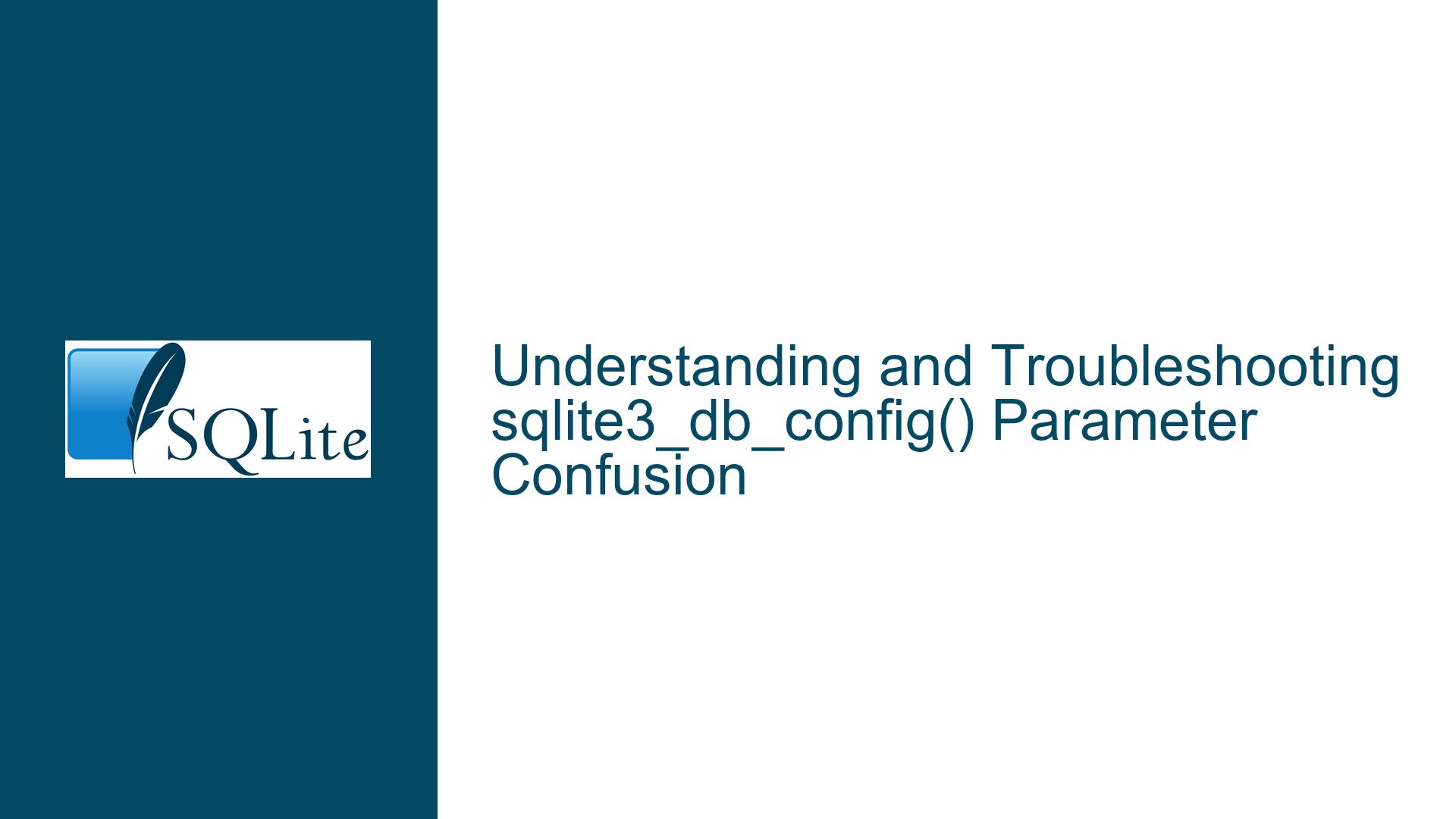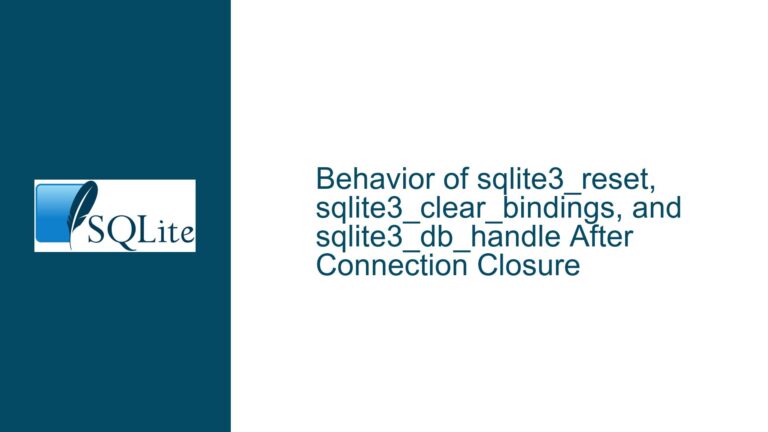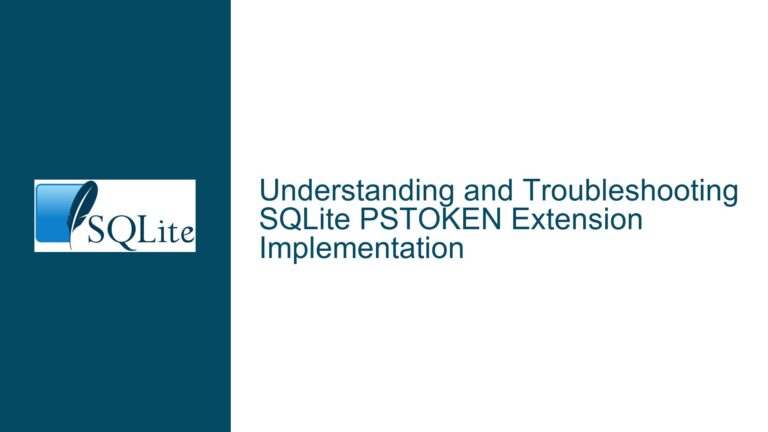and Troubleshooting sqlite3_db_config() Parameter Confusion
Issue Overview: Inconsistent Documentation and Segfaults in sqlite3_db_config()
The sqlite3_db_config() function in SQLite is a powerful tool for configuring database connections at runtime. However, its documentation has been a source of confusion, particularly regarding the varargs parameters required for different configuration options. The primary issue revolves around the inconsistency in the documentation, which fails to clearly specify the number and purpose of varargs parameters for each configuration option. This has led to runtime errors, including segmentation faults (segfaults), when developers attempt to use the function without fully understanding its requirements.
The core of the problem lies in the fact that most configuration options require two varargs parameters: the first to set the desired configuration value and the second to retrieve the current configuration value. However, this is not uniformly documented across all configuration options. For instance, the documentation for SQLITE_DBCONFIG_DEFENSIVE does not mention the need for a second varargs parameter, leading developers to assume that only one parameter is required. This assumption can result in undefined behavior, including crashes, especially when the second parameter is omitted or incorrectly specified.
The issue is further complicated by the fact that some configuration options, such as SQLITE_DBCONFIG_MAINDBNAME and SQLITE_DBCONFIG_LOOKASIDE, have different varargs requirements. These exceptions are not clearly highlighted in the documentation, making it difficult for developers to anticipate and handle these cases correctly. As a result, developers may spend significant time debugging issues that could have been avoided with clearer documentation.
Possible Causes: Misunderstanding Varargs Parameters and Undocumented Behavior
The root cause of the confusion and subsequent runtime errors stems from several factors. First, the sqlite3_db_config() function uses a variable number of arguments (varargs), which inherently makes it more challenging to understand and use correctly. Varargs functions require careful handling of the arguments passed to them, as the compiler cannot enforce type safety or the correct number of arguments. This places the burden on the developer to ensure that the correct number and type of arguments are provided.
Second, the documentation for sqlite3_db_config() does not consistently describe the varargs requirements for each configuration option. While some options, such as SQLITE_DBCONFIG_ENABLE_FKEY, clearly document the need for two varargs parameters, others, like SQLITE_DBCONFIG_DEFENSIVE, do not. This inconsistency forces developers to rely on trial and error or to delve into the SQLite source code to determine the correct usage.
Third, the behavior of sqlite3_db_config() when incorrect or insufficient varargs are provided is not well-documented. In some cases, the function may appear to work correctly, especially if the second varargs parameter (used to retrieve the current configuration value) is omitted but the function does not attempt to write to that location. However, in other cases, particularly when the function does attempt to write to the second parameter, the result can be a segmentation fault or other undefined behavior.
Finally, the presence of configuration options with unique varargs requirements, such as SQLITE_DBCONFIG_MAINDBNAME and SQLITE_DBCONFIG_LOOKASIDE, adds another layer of complexity. These options do not follow the common pattern of requiring two varargs parameters, and their documentation does not always make this clear. This can lead to confusion and errors when developers assume that all configuration options follow the same pattern.
Troubleshooting Steps, Solutions & Fixes: Clarifying Varargs Usage and Ensuring Correct Configuration
To address the issues surrounding sqlite3_db_config(), developers should take a systematic approach to understanding and using the function correctly. The following steps outline a comprehensive strategy for troubleshooting and resolving the common pitfalls associated with this function.
Step 1: Review the Documentation Carefully
Before using sqlite3_db_config(), developers should thoroughly review the documentation for both the function itself and the specific configuration options they intend to use. While the documentation may be inconsistent, it often contains valuable hints and examples that can help clarify the correct usage. Pay particular attention to any notes or comments in the documentation that describe the varargs requirements for each configuration option.
Step 2: Consult the SQLite Source Code
When the documentation is unclear or incomplete, consulting the SQLite source code can provide valuable insights into the correct usage of sqlite3_db_config(). The source code for the function, available in the SQLite repository, contains comments and logic that can help clarify the expected varargs parameters for each configuration option. By examining the source code, developers can gain a deeper understanding of how the function works and avoid common pitfalls.
Step 3: Use Consistent Varargs Patterns
For most configuration options, sqlite3_db_config() expects two varargs parameters: the first to set the desired configuration value and the second to retrieve the current configuration value. Developers should adopt a consistent pattern of providing both parameters, even if the second parameter is not needed. This approach ensures that the function behaves predictably and reduces the risk of runtime errors.
For example, when setting the SQLITE_DBCONFIG_DEFENSIVE option, developers should provide both the desired value (e.g., 1 to enable defensive mode) and a pointer to an integer variable to retrieve the current setting. If the current setting is not needed, the second parameter can be set to NULL. This pattern should be followed for all configuration options unless the documentation explicitly states otherwise.
Step 4: Handle Exceptions for Unique Configuration Options
Some configuration options, such as SQLITE_DBCONFIG_MAINDBNAME and SQLITE_DBCONFIG_LOOKASIDE, have unique varargs requirements that differ from the common pattern. Developers should carefully review the documentation for these options and ensure that they provide the correct number and type of arguments. When in doubt, consulting the SQLite source code can help clarify the expected usage.
For example, the SQLITE_DBCONFIG_MAINDBNAME option requires a single varargs parameter: a pointer to a string that specifies the name of the main database. The SQLITE_DBCONFIG_LOOKASIDE option, on the other hand, requires three varargs parameters: a pointer to a buffer, the size of the buffer, and the number of slots in the buffer. Developers should be aware of these exceptions and handle them appropriately in their code.
Step 5: Test Thoroughly and Use Debugging Tools
After implementing sqlite3_db_config() in their code, developers should thoroughly test the function to ensure that it behaves as expected. This includes testing both the common case (two varargs parameters) and any exceptions (unique varargs requirements). Testing should cover a range of scenarios, including edge cases and error conditions, to identify any potential issues.
In addition to testing, developers should use debugging tools such as Valgrind to detect memory errors, segmentation faults, and other runtime issues. These tools can help identify problems that may not be immediately apparent during testing and provide valuable insights into the root cause of any issues.
Step 6: Contribute to Documentation Improvements
Finally, developers who encounter issues with sqlite3_db_config() should consider contributing to the improvement of the SQLite documentation. By providing feedback, submitting patches, or suggesting clarifications, developers can help ensure that future users of the function have a clearer and more consistent reference to guide their usage. This collaborative effort can lead to better documentation and fewer issues for the entire SQLite community.
In conclusion, while sqlite3_db_config() is a powerful and flexible function, its usage can be challenging due to inconsistent documentation and the complexity of varargs parameters. By following a systematic approach to understanding and using the function, developers can avoid common pitfalls and ensure that their code behaves as expected. Thorough testing, careful review of the documentation and source code, and a consistent approach to varargs usage are key to successfully troubleshooting and resolving issues with sqlite3_db_config().






